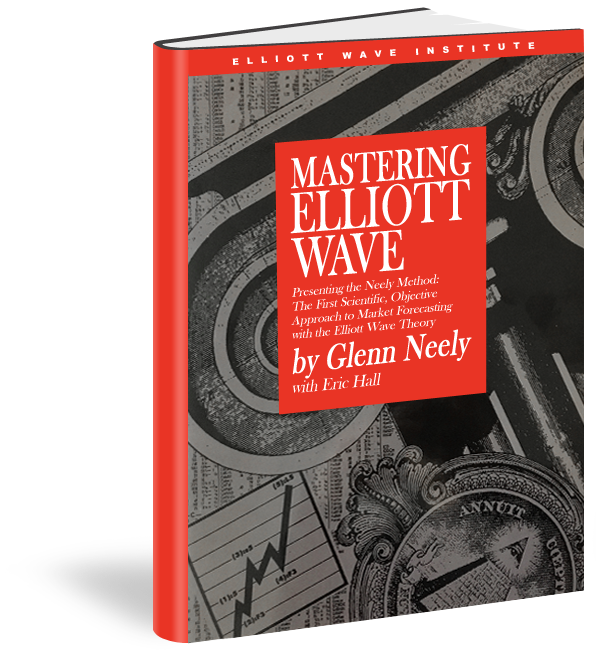Mastering Elliott Wave
By Glenn Neely
Chapter 1: Elementary Discussions
What is the Elliott Wave Theory?
Price Patterns of Psychology
From an Elliott Wave perspective, the plotted price activity of a market is the graphical representation of crowd psychology. The Wave Theory describes how local plotted data relates to surrounding data, how data should behave under a multitude of circumstances, when and how psychological trends begin and end, how one psychological environment mandates the unfolding of another and what general shape the price action should exhibit upon completion. In other words, the Elliott Wave Theory organizes the seemingly random flow of market price action into identifiable, predictable patterns based on the natural progression of crowd psychology.
Individuals behave in certain ways depending on their current opinions and feelings. When elated, that individuals actions will invariably be distinctly different from the same individuals actions when depressed. Just the way one person can feel excited or concerned about his or her personal future, the same feelings can permeate and be manifested by society. When a majority of people have similar feelings (favorable, unfavorable, indifferent) about their, or society's, prospects for the future their cumulative action unfolds in predictable patterns. In addition, the same way an individual can change his or her mind over time (occasionally in an instant), so can the crowd. The Crash of 1987 was a good example of an almost universal, "instant" change in the crowd's opinion of the stock market and the future of the United States economy.
Once a certain psychological mood has run its course, people tend to get bored with an idea or concept (sometimes financially ruined by them), so they grab onto new ideas. It is this changing from one mood to the next that terminates one psychological trend (price pattern) and begins another.
Natural, Non-Periodic Phenomenon
The amount of time consumed by a specific pan-societal mood appears to have no absolute minimum or maximum time requirement, but there are general limits. By analyzing previously completed patterns and applying certain principles of time behavior, it is possible to approximate the best time periods for completion of a formation. These techniques, many of which I have developed over the last ten years, will be discussed in later chapters.
The "structure" of market movement should almost always supersede time observations. Some people consider this an annoying aspect of the Theory since they want to know "when" to make a trade, in advance! Elliott virtually proves that absolute anticipation of market movement is impossible. The greatest degree of predictability occurs immediately after a move has terminated. In other words, you wait for a pattern to complete, then you take action.
A Unique Analytical Tool
Unlike most forms of technical analysis, the Wave Theory was developed strictly from a price behavior standpoint. The Theory helps the analyst realize that whatever the market does, it does for a reason. There is no "chance" in market activity, no aberrations and no unclassifiable price behavior.
A large portion of market technicians spend their time tying to manipulate price data to find that "magical" key-indicator. How can a transformation of price data be better than the original data? In other words, price should be considered the ultimate indicator. It is the only indicator of market action that can be absolutely depended on and the only one that directly affects your bottom line. It does not make any difference what someone thinks or what an indicator signals, the bottom line is, "what did the market do?" If prices are going up (and you are long), you make money. If prices are going down (and you are long) you lose money, all other indicators notwithstanding.
Some of the remarkable aspects of the Elliott Wave Theory are:
- Its adaptability to new technological developments and unexpected fundamental news;
- Its thoroughness in describing ALL possible market behavior; and
- Its progress and dynamic characteristics.
The Theory inherently indicates man, and his markets, continually charts new territory and types of behavior. It stipulates that at no point in history is a market's action or psychological environment identical to any other period. Similarities are allowed, but no exact duplication. This can be a problem for traders, and especially "system" developers, who endeavor to formulate strategies based on historic price action and behavior. Unlike most systems and forms of analysis, the Wave Theory warns the analyst to look for change and warns him when and where a market will not behave as it has in the past.
The "Elliott" point of view, that "history does not repeat exactly" is the perfect explanation of why most mechanical systems (and other forms of analysis based on the expectation of exact repetition) fail. This is particularly evident when a market changes from a bullish to bearish environment, or vise versa.
The computer age has dramatically (and probably permanently) altered certain aspects of the trading environment and thus market behavior. This is an example of why working with historical data way back to "who knows when" will not necessarily make a mechanical system function any better. Every expanding technology continually transforms the decision element of the market, people. The way people react to, use and learn from new technology cannot be decided by historical study. A form of analysis which explains, categorizes, and structures progress, not repetition, is needed. That is what the Elliott Wave Theory is capable of doing.
Additional Examples
The 1987 crash was a perfect illustration of how a study of history could not have prepared one for what happened October 19, 1987. Even the largest declining data during the crash of 1929 was only half as detrimental (percentage-wise) as the one experienced in 1987. Anyone using the 1929 crash as a barometer may have decided to buy the market after it had fallen 10% or so the day of October 19, 1987, expecting no day to be worse than that experienced in 1929. Of course, anyone taking such an approach would have been in for a very unpleasant surprise.
During the 1987 advance, I remember continually hearing people talk about (and seeing ads espouse) the extreme similarities between 1982-1987 and 1920-1929. They assumed everything would continue on course exactly (same time and percentage advance), with the 80's bull market repeating the nine year boom as if it were another 1920-1929. Unfortunately, those who believed such an easy comparison of history was their road to riches may now be doing something besides investing in the stock market.
Why Learn Elliott Wave Theory?
To the beginning student, the Theory's complexity, multiple pattern variations, "alternate count" possibilities and apparent subjectivity seem almost insurmountable and appear to nullify the Theory's validity. This is due to the extreme demand of specifics required of the Elliott Wave analyst. All general pattern categories, and each of its variations, requires different relationships, channeling, price behavior and technical characteristics. This creates the illusion that the Theory is purely subjective and can be molded to fit anyone's opinion. While there may have been some justification for this stance in the past, before the publication of this book, this simply is not true anymore. The Pre-Constructive and Post-Constructive Rules of Logic (Chapters 3 & 6, respectively) in collaboration with numerous, completely new techniques developed by the author over many years, will greatly enhance your ability to arrive at a single wave pattern conclusion. Caveat: The techniques, and the specifics involved in applying them, are so numerous and varied that their proper application can take years of practice and real-time trading. As a result, until you thoroughly understand the concepts presented in this book, your conclusions may frequently be incorrect.
Multiple Benefits
The long-term benefits of "Mastering Elliott Wave" are numerous. As a business person or investor, you can frequently anticipate major changes in the economic environment allowing you to sidestep disaster or even profit from the winds of change. Proper understanding of crowd psychology (the fundamental basis of the Theory) can help you avoid financially dangerous business dealings at the end of an economic cycle.
Multi-area application
The Wave Theory can be applied to virtually all areas of mass human endeavor: the stock market, commodities, real estate, production of goods and services, etc.; all that is required is accurate, consistent data. The benefits of the Theory's multi-area application are obvious.
Numerous Techniques Unnecessary
When incorporating Elliott's original rules and observations with the Neely Method and the new technology revealed in this book you have at your disposal a virtually all encompassing description of market behavior and how to decipher it. This allows you to know, under most circumstances, a great deal about the current position of a market without any information other than price action. You will not need to keep track of numerous time consuming (and sometimes subjective) indicators.
Remember, no matter how good a mechanical system or indicator works during a particular period in history, the minute the pattern (which was unfolding during the formation of the system) completes, that system or indicator will usually not work anymore. The environment in which it was designed to perform so perfectly no longer exists and (according to Wave Theory) will never exist again.
Helpful in Indicator Clarification
If you decide to use other indicators (outside of Elliott) to "clarify" wave counts, the Wave Theory is actually instructive in quality where and when a particular indicator does and does not work.
Example:
Readings of investor sentiment normally indicate a significant market turning point only when in overbought or oversold territory (usually considered to be around 75% and 35%, respectively). A comprehensives understanding of Elliott patterns allowed me to recognize in 1986 and 1987 that sentiment could oscillate around neutral readings even if a major market turning point was forming. This was a logical deduction based on an understanding of Horizontal Triangles and Terminal patterns (ex. Gold Jan.-June 1986 and S&P 500 Jan.-Sept 1987). When most were confused by the lack of public excitement generated during the 1987 stock market advance, I constantly warned clients that was a sign a Terminal Impulse wave (diagonal triangle) started in the last quarter of 1986 and would portend a crash, in three months or less, back to 1900 on the DOW and 230 on the S&P500 Cash Index.
Signals Infrequent, but Reliable
Only after an identifiable pattern is complete is it safe or desirable to enter a market. This helps avoid over-trading and prevents entering the market when there is little potential. On the other hand, it promotes trading when the probabilities are greatly in your favor and risk is at a minimum. The Theory also allows for the placement of very objective stops, enabling you to know when in time and where in price your interpretation is wrong. What else could a trader ask for?
Why the Controversy?
Complexity
The Wave Theory is probably the most complex and all encompassing form of market analysis ever devised. It requires a lot of time and practice to master. As a result, most people do not have the time nor inclination to properly learn or apply it. The Theory takes more time to perfect than most people are willing to commit. In addition, the idea of an analytical technique allowing someone to call market turning points to the day, even the hour, is considered by most to be ridiculous or at least suspect. When a majority of investors have trouble being on the right side of a market, attempting to pick the highest or lowest tick of a trend is not even considered a serious possibility. A Theory which professes to produce such astounding results will always create controversy and be treated with skepticism by the uninitiated.
Public Mind Set
Profitable application of the Wave Theory requires a mentality divergent from the norm. To accurately call market turning points demands you buck the crowd precisely at the time the majority is most convinced an event will occur (you may possibly even be ridiculed for your beliefs, one of the most reliable signs your analysis is correct). Extreme self-control is a must; control of greed, strict money management (with includes risk control), an open mind and the ability to change your entire perspective (from bullish to bearish or vice versa) in the blink of an eye are all necessary attributes and abilities of the successful analyst and/or trader. Most of these characteristics are not all present in one person, making it difficult to be a prognosticator and profitable investor. Many people can predict future market action when no money of their own is at risk. When trading becomes personal, everything changes.
Years to Master
Even if you had all of the qualities mentioned above, it could take years of practice to confidently and accurately apply the Theory to real-time. Since most people will not spend the time necessary to properly learn the Theory, they misapply it and lose money in the market. This creates disgruntled "ex-students" who, of course, blame their misfortune on the Theory, thus continuing the controversy.
Application Requires Time
Even if you have the mentality and the years of experience and knowledge, you still must spend time analyzing everyday or so to stay in practice and keep up with the current position of a market. If you are following numerous markets, this alone can take several or more hours everyday.
On many occasions, I have spent an entire weekend looking at one market, sometimes just one chart, trying to figure a way to fit all the important elements of a good count into the price patterns. Most people want making money in the market (and all other endeavors) to be easy. They work all day at another job, go out to eat, go to the movies, then right before going to bed in the evening, spend 5 or 10 minutes on their charts to "decide" what the market is going to do the next day.
This is just one of the many reasons most people never make money trading. If you are in the above mentioned category, you are competing against a handful of devoted, full-time professionals who derive their sustenance from profitable trading or investing. The chances of a part-timer consistently winning against this group are small. If you are not able to spend the time required to follow markets properly, it is recommend you find a professional who can advise you on your investments.
Endless Array of Specifics
To apply Elliott Wave properly under all circumstances requires the application of an almost endless array of specific criteria fitting particular situations. Relationship, channeling, the significance of certain turning points to the over all picture, Structure (Impulsive or Corrective and what type of Impulsion and Correction) all need to be considered when piecing together a pattern's count.
Memorization
From the statements on the previous pages, it should be obvious that a large amount of information needs to be memorized in order to hasten the application of important Elliott Wave and Neely techniques to a price series. The memorization is one of the major obstacles most students encounter to successful application of the Wave Theory in real-time action.
Frequent Indeterminacy
The price or time termination area of a trend is not predictable, with a high degree of confidence, until an Elliott Wave pattern is on the verge of completion. Sometimes, confidence is not obtainable until after a pattern has completed. This fact keeps most of the public suspicious about the Theory. Why? If you ask an Elliottician for his prediction of future market activity before a pattern is near completion, the probabilities are high his analysis will be wrong, at least in detail. As the market approaches the other end of a move, the pattern in progress begins to become clear. As it moves away from the identified turning point of a previous pattern and moves toward the middle of a new pattern, the number of possible patterns in progress again increase. This is the reason experienced Elliott analysts can disagree on the position of a market during certain time periods; each is choosing what he or she considers to be the best scenario of the interpretations possible.
When experts in the same field continuously disagree on the same subject, this is the very foundation of controversy. In a latter chapter, a whole new concept developed by the author, will be introduced to handle these areas of "uncertainty" (see Expansion of Possibilities – Page 12-43).
Difficulty
The extreme complexity, subtlety, and demanding nature of the Wave Theory prevents most people from pursuing this area of analysis. Also, most of the reasons listed throughout Chapter 1 prevent the Theory from being completely computerized. Application of the Theory sometimes demands forms of abstract thought, not a specialty of the computer realm. For example, application of all the rules under certain circumstances may leave no obvious possibilities. These situations require personal brainstorming sessions to "unlock" the count or, sometimes, merely patience to wait for a count to reveal itself.
Mastery of this form of analysis will be applicable for the rest of your life. There is no need to concern yourself with the possibility of heavy public participation, most will apply it wrong. As Elliott has become increasingly popular, the wave patterns in most markets, to compensate, have begun to develop an on ever more complex level preventing amateur Elliotticians from correctly deciphering market behavior. Again, this helps to perpetuate the controversy in favor of the Theory's inadequacy or, at the very least, its supposed subjectivity.
Why This Book May Create More Controversy
The degree of detail in this book will significantly increase the number of important rules and guidelines that have to be memorized to properly apply the Theory. Most people feel there are already too many rules associated with Elliott Wave.
Many experienced practitioners will disagree with some of the findings in this book proclaiming "my wave behavior criteria is too specific or demanding to be applied to real-time market action." This is absolutely not true. It is understandable, though, how these feelings might have come about in others. Many practitioners have, for years, used data to plot their charts which is inaccurate or improperly plotted forcing them into invalid conclusions. This obviously would affect their perception of the Wave Theory. When data is inconsistent (which it will be when collected and plotted incorrectly), it is impossible to analyze a market's action with exactitude. [For a more detailed description of what constitutes good data and how to plot it, see "How Do You Plot Data To Analyze Waves," in Chapter 2.]
What Makes Elliott Wave Theory Unique?
Complete Perspective
Unlike most all mechanical systems and many analytical techniques, the Elliott Wave Theory allows the analyst to study any time frame: hourly, daily, weekly, monthly, yearly, etc. Even more interesting, the analyst can study all time frames simultaneously, allowing a decision to be made on which time frame currently provides the greatest trading environment and how all the long and short-term movements interplay with one another.
Quantification of Mass Psychology
Even if a system or technique tells you what to do in the market, rarely will it give you a feeling for the economic outlook of a society or of the psychology overshadowing all market action. Due to the Theory's mathematical quantification of mass psychology, it allows you to experience the economic "boom and bust" phenomenon with greater interest and understanding.
Detailed Categorization
Almost in a class by itself, Elliott allows for the categorization of moves which cover just a few seconds in length up to hundreds of years. Every move on a price chart has its effect on the larger patterns that are evolving and each can be labeled based on it specific impact. If you know what type of pattern is unfolding, you have a better idea of what to expect from that move in the area of speed, complexity, breadth, volume, etc. (many of these areas will be covered later).
Grand Simplification
The whole Elliott Wave analysis process involves the deciphering of small price patterns, combining those with numerous others into larger price patterns and then reducing those complex patterns back into simpler patterns again. This is what makes the Theory so unique; development is the same on all scales.
Clear Delineation of Price Behavior
No matter how small or large a trend turns out to be, you can clearly label the movement as an upward correction in a downtrend, a downward correction in an uptrend, etc.
How Should You Learn the Theory?
Reading this book is a good start! "Mastering Elliott Wave" (the book and the process) requires a lot of real-time practice. Initially, your charts should be constructed on a short-term basis until you grasp the basic concepts. Memorization of numerous rules is required along with an understanding of general shapes and channeling. It is recommended you follow no more than one market until you have memorized the basic rules and can quickly apply them to a market as it unfolds in real-time.
Why Another Book on Elliott Wave was Necessary
Additional Techniques Required
The purpose of this book is to provide new, introductory methods to assure objective application of the Theory and, in later chapters, discuss more subtle qualifying techniques. These will be required by the experienced analyst to enhance the wave tracking process. These techniques can be employed even when the market is developing on a very complicated basis, eliminating the need to resort to other types of less reliable indicators or techniques.
Specific Procedures Described
Despite the preponderance of information now available on Elliott, most people interested in the subject do not know where to begin when trying to apply it to real-time. The approach in this book is to logically progress from the simplest concepts (many of which were developed for the benefit of my course clients), to the more complex as each stage of wave analysis is understood. In addition, exact start-up procedures and data-plotting methods will be explained in detail.
Realistic Diagrams Previously Non-Existent
Even in Elliott's original works, diagrams of market behavior were very poor and unrepresentative of real-time market action. In my early days of fighting with the Theory, those diagrams were a strong influence on my thinking. The idealized patterns never reflected actual market behavior. Any student familiar with Elliott's original works will greatly appreciate the attention to "real-life" detail present in the charts of this book. In the early sections of the book, the "typical" diagrams are used to instill the general shape of each Elliott pattern, but they are quickly discarded later for more accurate representations.
Disclosure of Advanced Concepts
Even though general descriptions of Elliott's tenets can be found in all writings on the subject, very little is available on advanced techniques and applications. It is in that area that this book really excels.
Original Presentation Sequence
The difficulty most students have in the early stages of learning Elliott Wave is mostly due to the standard method of presentation. A lot of importance is placed on what I call "Progress Labels" (1,2,3,4,5,a,b,c) too early in most publications. That area of knowledge is of little importance in the early learning stages; it just tends to confuse if discussed too soon. Also, far too much significance is placed on Degree in Elliott's work and its spinoffs. If there is any aspect of the Wave Theory that is subjective, Degree is it. For the above reasons, both concepts are presented after more basic ideas are covered.
New Terminology
The difficulty of discussing the Wave Theory over the phone to clients and in book form required the creation of new terminology in order to convey precise meanings. Some coined words and phrases were also needed to describe new discoveries and techniques covered in this book. In addition, a few old terms have been renamed for clarity. Many "Standard and Non-Standard" Elliott patterns have been broken down into more specific sub-categories. This was done to aid the application of "pattern specific" rules and guidelines which will enhance your forecasting accuracy and pattern interpretation.
New Discoveries, The Neely Extensions
Initially, I intended to include a separate section on all the new discoveries (channeling, Fibonacci, price, time, structure, patterns, degree, relativity, momentum) I had made over the years. This proved too difficult. For the completeness of each section, the presentation of only old information first then new information later would have required introducing all the same categories twice. For reasons of continuity and space preservation, each new technique, concept or discovery has been introduced at its proper place with the assumption that the reader will clearly detect the presence of "never before presented" information. The value of these Extensions to Elliott's work will be proven to anyone who applies them properly. For those new techniques, concepts and discoveries which could not be included in the normal flow of the text, there are several sections toward the end of the book which present information that has either never been presented before (i.e., Rule of Similarity and Balance, The Neely Extensions, Complexity Rule, Power Ratings, Logic Rules, Emulation, Reverse Logic Rule, Missing Waves, etc.) or have only been implied but never explained in detail (i.e., Structure Series, the dominance of Structure over Progress Labels, Compaction, Progress Label Application, the importance of Channeling, the differences between Extensions and Subdivisions, etc.).
How I Discovered these New Concepts and Techniques
The Telephone Course
When I started my studies of the Wave Theory, many things appeared to be missing from available literature on the subject. Questions like; "where do you start a chart, how do you organize charts, how do you plot price action, how do you analyze and treat a near vertical advance or decline on a price chart that exhibits no up and down price action?" came to mind. This, along with the frustration I experienced when wrong about the direction of a market's move, kept me searching for answers. Refusing to believe a market could outwit me, I believed with enough time and work the Theory could be reduced to a scientific approach where all market action could be explained and most future action could be anticipated. My purpose was to eliminate any subjectivity in the analysis process, therefore allowing rational, logical trading decisions to prevail.
In an attempt to explain market action which did not fit into the Wave Theory as R.N. Elliott described it, I set out to quantify every unquantified facet. As part of this study, eight years of notes were kept on all manner of market behavior in an attempt to classify and regiment market action above and beyond Elliott's original discoveries.
Most of what I have discovered has come from teaching a "one of a kind" Telephone Course on the Theory since 1983. Due to this detailed teaching process, new ways of presenting the Theory to beginners, important wave behavior discoveries (sometimes very subtle and specific), Channeling techniques, Fibonacci relationships and charting approaches emerged. Through constant application and research I believe I have quantified almost every, up till now unquantified aspect of the Theory.
Long Hours of Work
Since I generally work seven days a week, ten to fifteen hours a day and have been studying this subject since 1980, I estimate I have logged more than 30,000 hours in the study of Elliott Wave Theory. This alone was a good breeding ground for new ideas.
Where is the Theory Applicable?
The Wave Theory manifests itself in markets that have broad public appeal and involvement. Markets that are more susceptible to weather and other natural events are less reliable followers of the Wave Theory since the weather is not dependent on human thoughts or actions. Many individual stock issues are not broadly based enough to set into motion this natural law of mass human psychology and so may not yield consistent results. On the other hand, markets such as gold, broadly based stock averages or real estate (even though reliable data is hard to obtain for real estate), work well since little can happen to change the value of the commodity or index except human action. Virtually any mass human endeavor will exhibit predictable progress as long as there is consistent, reliable data available.
How Should You Work with and Perceive Elliott?
Meticulously
All market action needs to be accounted for and classified to produce bankable interpretations. Counts should be built from the ground up on a "molecular" basis. Do not start the analysis process by trying to interpret a long-term price chart first. The long-term count is the by-product of all the short-term studies. Keep your short-term analysis accurate and the long-term possibilities will usually become evident as they unfold.
Once charts are organized on a daily, weekly and monthly basis, the analyst should patiently work with the short-term data until a clearly definable pattern appears. Later it will be discussed what to do with the completed pattern and what part of the whole the pattern becomes.
The Elliott Wave Theory is the graphic representation of a natural law which is continuously at work in all areas of mass human activity. As an analyst working with the Theory, do not try to create count scenarios or force the market into a pattern which would favor your current opinion of where the market should be headed. Let each pattern evolve, then objectively deduce how that pattern, based on the highest probabilities, fits into a grander scheme.
Elliott frequently allows you the pleasure (intellectually and financially) of calling major turning points to the day or even the hour. At these junctures you will be a "lone voice in the woods." If you have the courage to act on your convictions, the Elliott Wave Theory will produce results for you.
Open-Mindedly
To properly apply the Theory requires an open-mind to all possibilities. Never begin the analysis of a market with a preconceived scenario and then attempt to mold an Elliott count which would verify your opinions. Your conclusions should be the by-product of a carefully constructed wave count. Also, try to avoid all optimistic or pessimistic impulses. When all techniques are followed correctly, you do not need to make a guess, the completed wave count will virtually tell you what price level the market should reach and in what time frame that should happen.
What's Next?
The next chapter of this book, General Concepts, is designed to answer basic questions you may have about the Wave Theory, but – until now – have gone unanswered. The third chapter, Preliminary Analysis, describes how to prepare and maintain chart data, how to identify waves, properly observe wave interaction and much more. Chapter 3 contains the most complete and methodical explanation of price analysis available. These techniques will allow the novice to accurately decipher even the most complex market conditions. The fourth chapter, Intermediary Observations, discuss how to combine individual waves into acceptable groups to form "standard" Elliott formations. Chapter 5, Central Considerations, advances further into the construction of specific Elliott patterns with numerous rules explained to eliminate unsatisfactory wave development. Chapter 6 introduces the Post-Constructive Rules of Logic discovered by the author. These rules will describe how to confirm the authenticity of patterns you have identified. Chapter 7, Conclusions, will help you solidify your wave patterns, simplify their Structure and prepare them for future use. Chapters 9-12 contain a vast array of mostly new pattern formulation, testing, and verification techniques.








